OPERATING, INVESTING AND FINANCING ACTIVITIES: THE BHP BIllition Company Corporate Accounting Deferred Tax Analysis
VerifiedAdded on 2021/06/16
|18
|3874
|176
AI Summary
BHP BIllition Company Corporate Accounting Deferred Tax analysis Name of the Author INTRODUCTION 1 ANSWER TO QUESTION NO- 1 1 ANALYSING INFORMATION PRESENT IN CASH FLOW STATEMENT 1 ANSWER TO QUESTION NO- 2 1 OPERATING, INVESTING AND FINANCING ACTIVITIES: A SUMMARISED EXPLAINATION 1 ANSWER TO QUESTION NO- 3 2 ITEMS REPORTED IN OTHER COMPREHENSIVE INCOME STATEMENT 2 ANSWER TO
Contribute Materials
Your contribution can guide someone’s learning journey. Share your
documents today.
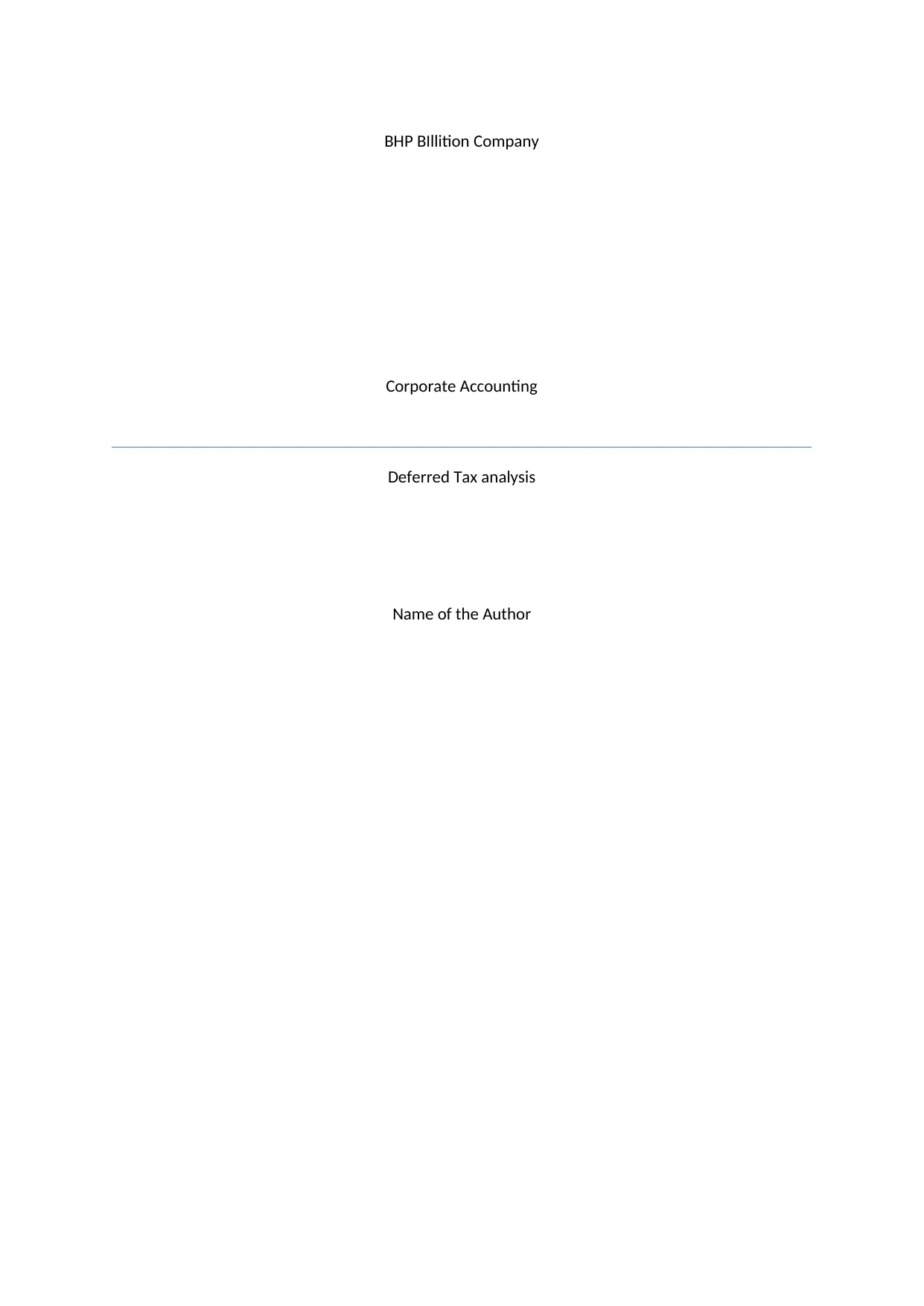
BHP BIllition Company
Corporate Accounting
Deferred Tax analysis
Name of the Author
Corporate Accounting
Deferred Tax analysis
Name of the Author
Secure Best Marks with AI Grader
Need help grading? Try our AI Grader for instant feedback on your assignments.
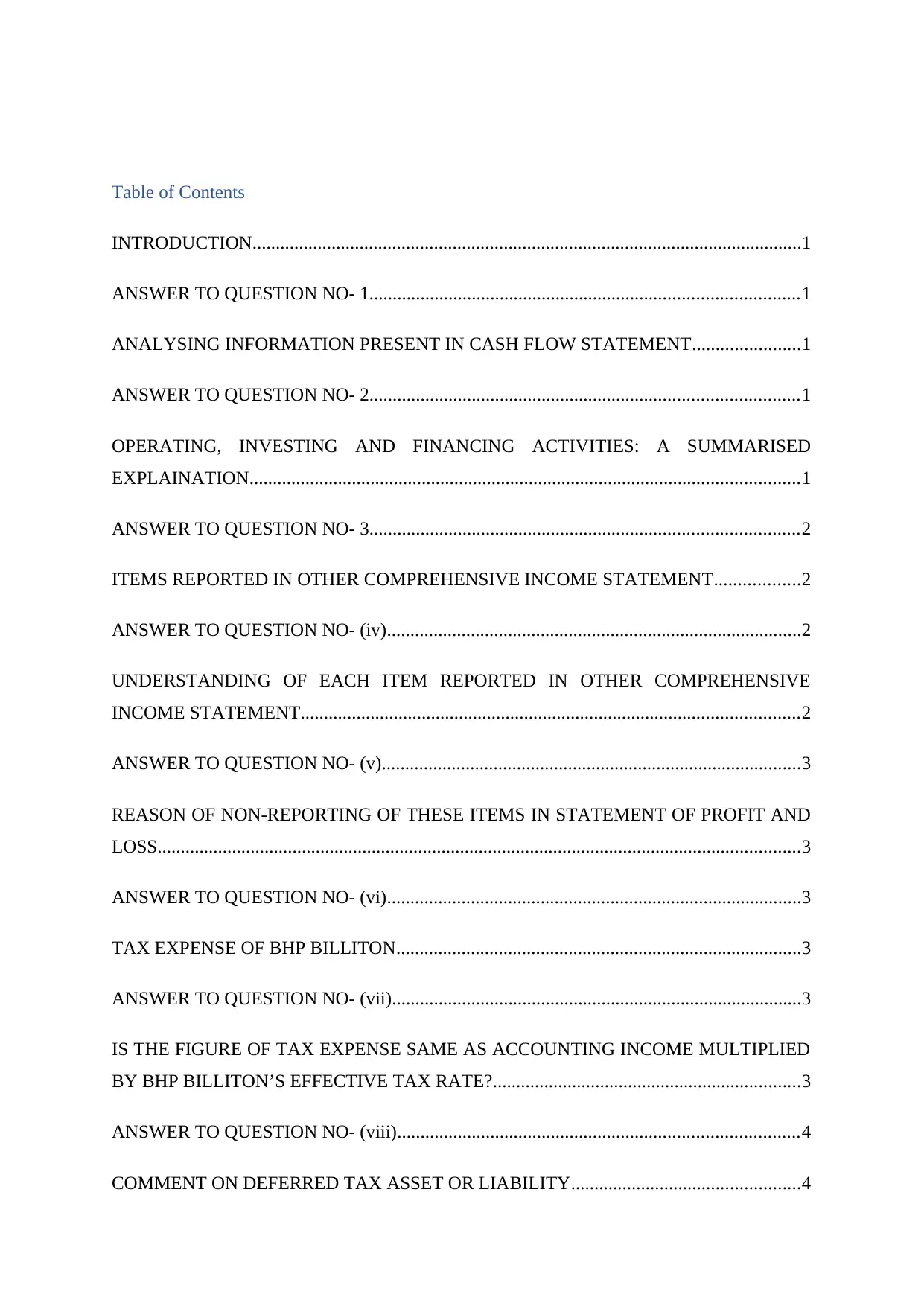
Table of Contents
INTRODUCTION......................................................................................................................1
ANSWER TO QUESTION NO- 1............................................................................................1
ANALYSING INFORMATION PRESENT IN CASH FLOW STATEMENT.......................1
ANSWER TO QUESTION NO- 2............................................................................................1
OPERATING, INVESTING AND FINANCING ACTIVITIES: A SUMMARISED
EXPLAINATION......................................................................................................................1
ANSWER TO QUESTION NO- 3............................................................................................2
ITEMS REPORTED IN OTHER COMPREHENSIVE INCOME STATEMENT..................2
ANSWER TO QUESTION NO- (iv).........................................................................................2
UNDERSTANDING OF EACH ITEM REPORTED IN OTHER COMPREHENSIVE
INCOME STATEMENT...........................................................................................................2
ANSWER TO QUESTION NO- (v)..........................................................................................3
REASON OF NON-REPORTING OF THESE ITEMS IN STATEMENT OF PROFIT AND
LOSS..........................................................................................................................................3
ANSWER TO QUESTION NO- (vi).........................................................................................3
TAX EXPENSE OF BHP BILLITON.......................................................................................3
ANSWER TO QUESTION NO- (vii)........................................................................................3
IS THE FIGURE OF TAX EXPENSE SAME AS ACCOUNTING INCOME MULTIPLIED
BY BHP BILLITON’S EFFECTIVE TAX RATE?..................................................................3
ANSWER TO QUESTION NO- (viii)......................................................................................4
COMMENT ON DEFERRED TAX ASSET OR LIABILITY.................................................4
INTRODUCTION......................................................................................................................1
ANSWER TO QUESTION NO- 1............................................................................................1
ANALYSING INFORMATION PRESENT IN CASH FLOW STATEMENT.......................1
ANSWER TO QUESTION NO- 2............................................................................................1
OPERATING, INVESTING AND FINANCING ACTIVITIES: A SUMMARISED
EXPLAINATION......................................................................................................................1
ANSWER TO QUESTION NO- 3............................................................................................2
ITEMS REPORTED IN OTHER COMPREHENSIVE INCOME STATEMENT..................2
ANSWER TO QUESTION NO- (iv).........................................................................................2
UNDERSTANDING OF EACH ITEM REPORTED IN OTHER COMPREHENSIVE
INCOME STATEMENT...........................................................................................................2
ANSWER TO QUESTION NO- (v)..........................................................................................3
REASON OF NON-REPORTING OF THESE ITEMS IN STATEMENT OF PROFIT AND
LOSS..........................................................................................................................................3
ANSWER TO QUESTION NO- (vi).........................................................................................3
TAX EXPENSE OF BHP BILLITON.......................................................................................3
ANSWER TO QUESTION NO- (vii)........................................................................................3
IS THE FIGURE OF TAX EXPENSE SAME AS ACCOUNTING INCOME MULTIPLIED
BY BHP BILLITON’S EFFECTIVE TAX RATE?..................................................................3
ANSWER TO QUESTION NO- (viii)......................................................................................4
COMMENT ON DEFERRED TAX ASSET OR LIABILITY.................................................4
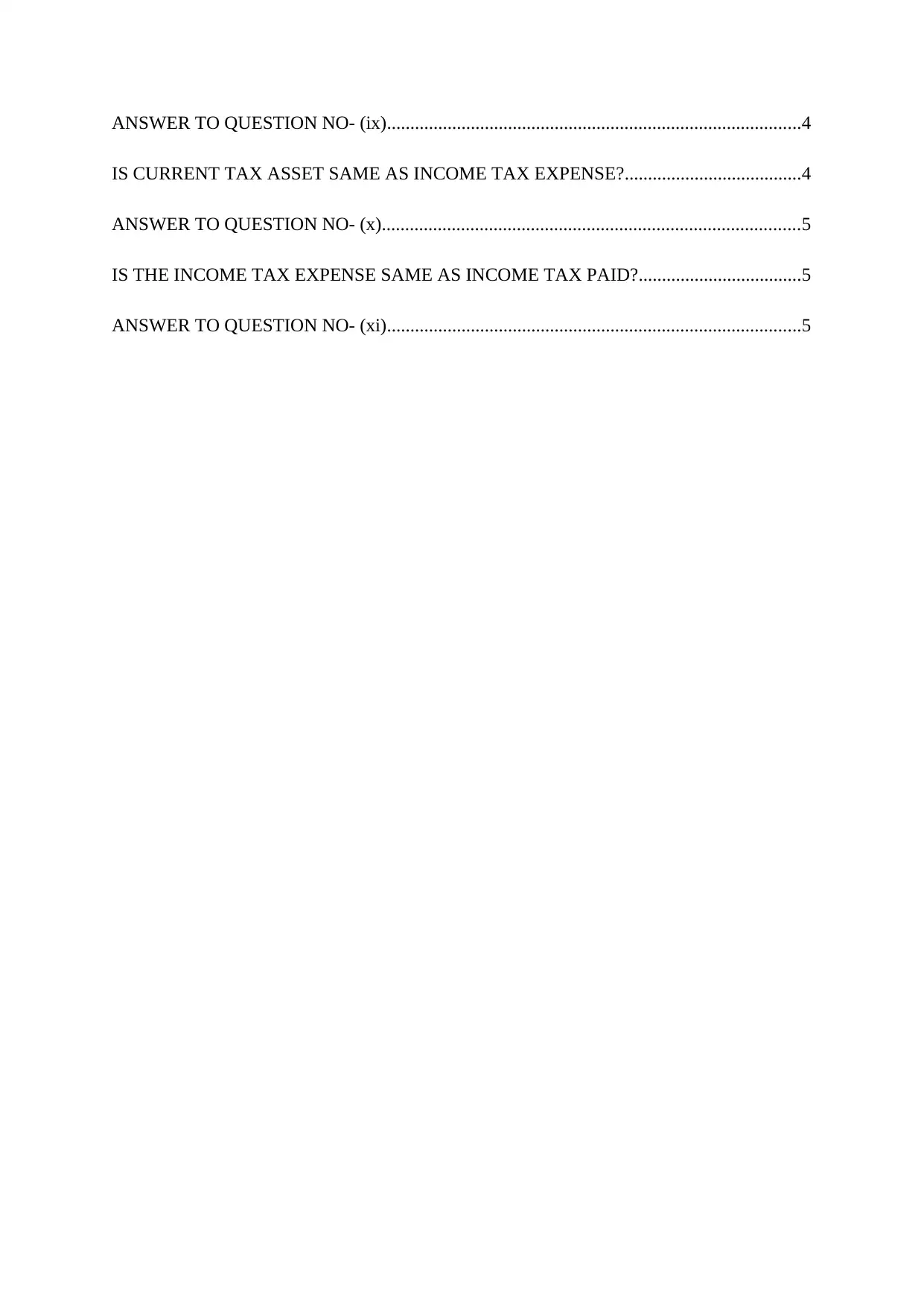
ANSWER TO QUESTION NO- (ix).........................................................................................4
IS CURRENT TAX ASSET SAME AS INCOME TAX EXPENSE?......................................4
ANSWER TO QUESTION NO- (x)..........................................................................................5
IS THE INCOME TAX EXPENSE SAME AS INCOME TAX PAID?...................................5
ANSWER TO QUESTION NO- (xi).........................................................................................5
IS CURRENT TAX ASSET SAME AS INCOME TAX EXPENSE?......................................4
ANSWER TO QUESTION NO- (x)..........................................................................................5
IS THE INCOME TAX EXPENSE SAME AS INCOME TAX PAID?...................................5
ANSWER TO QUESTION NO- (xi).........................................................................................5
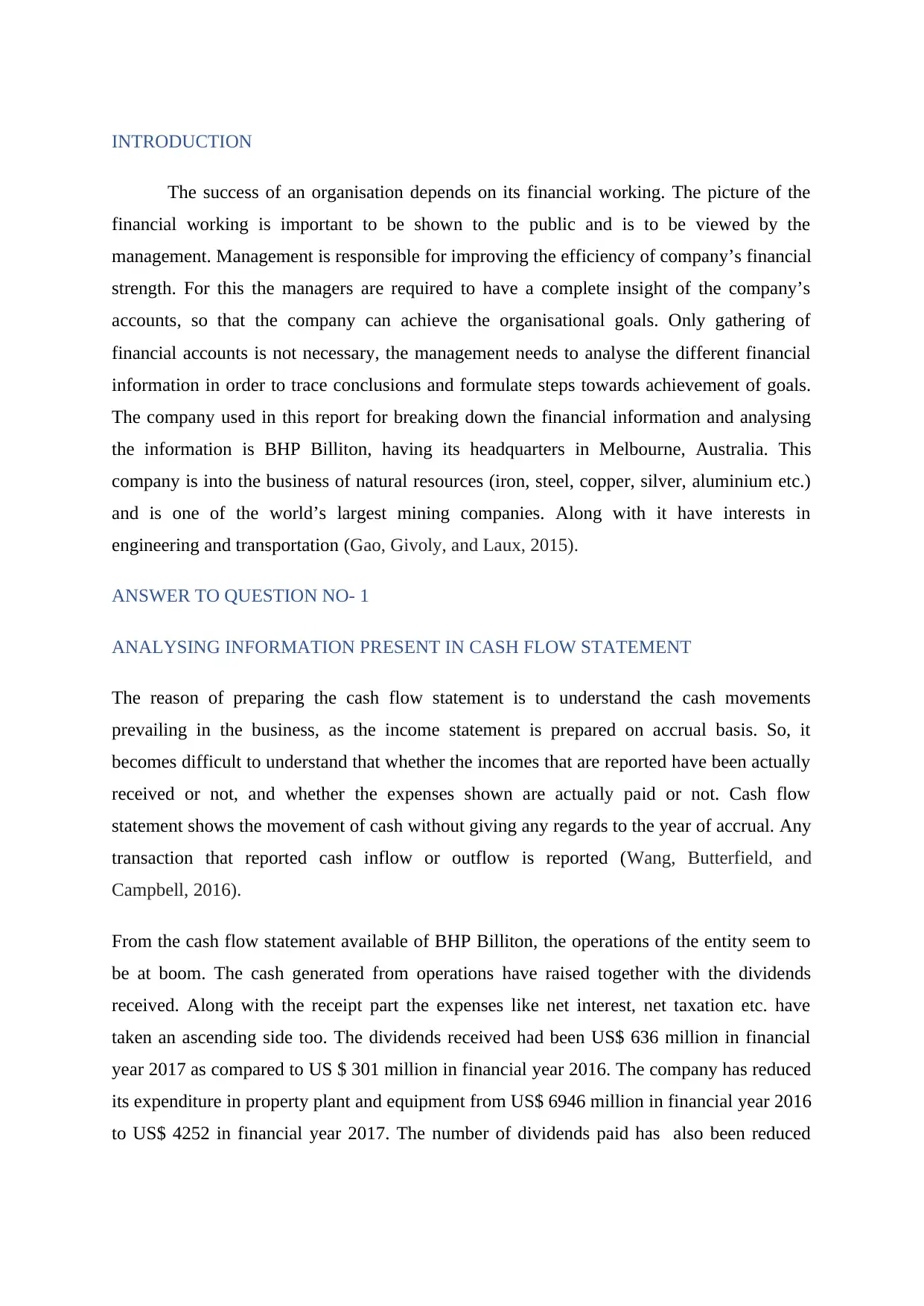
INTRODUCTION
The success of an organisation depends on its financial working. The picture of the
financial working is important to be shown to the public and is to be viewed by the
management. Management is responsible for improving the efficiency of company’s financial
strength. For this the managers are required to have a complete insight of the company’s
accounts, so that the company can achieve the organisational goals. Only gathering of
financial accounts is not necessary, the management needs to analyse the different financial
information in order to trace conclusions and formulate steps towards achievement of goals.
The company used in this report for breaking down the financial information and analysing
the information is BHP Billiton, having its headquarters in Melbourne, Australia. This
company is into the business of natural resources (iron, steel, copper, silver, aluminium etc.)
and is one of the world’s largest mining companies. Along with it have interests in
engineering and transportation (Gao, Givoly, and Laux, 2015).
ANSWER TO QUESTION NO- 1
ANALYSING INFORMATION PRESENT IN CASH FLOW STATEMENT
The reason of preparing the cash flow statement is to understand the cash movements
prevailing in the business, as the income statement is prepared on accrual basis. So, it
becomes difficult to understand that whether the incomes that are reported have been actually
received or not, and whether the expenses shown are actually paid or not. Cash flow
statement shows the movement of cash without giving any regards to the year of accrual. Any
transaction that reported cash inflow or outflow is reported (Wang, Butterfield, and
Campbell, 2016).
From the cash flow statement available of BHP Billiton, the operations of the entity seem to
be at boom. The cash generated from operations have raised together with the dividends
received. Along with the receipt part the expenses like net interest, net taxation etc. have
taken an ascending side too. The dividends received had been US$ 636 million in financial
year 2017 as compared to US $ 301 million in financial year 2016. The company has reduced
its expenditure in property plant and equipment from US$ 6946 million in financial year 2016
to US$ 4252 in financial year 2017. The number of dividends paid has also been reduced
The success of an organisation depends on its financial working. The picture of the
financial working is important to be shown to the public and is to be viewed by the
management. Management is responsible for improving the efficiency of company’s financial
strength. For this the managers are required to have a complete insight of the company’s
accounts, so that the company can achieve the organisational goals. Only gathering of
financial accounts is not necessary, the management needs to analyse the different financial
information in order to trace conclusions and formulate steps towards achievement of goals.
The company used in this report for breaking down the financial information and analysing
the information is BHP Billiton, having its headquarters in Melbourne, Australia. This
company is into the business of natural resources (iron, steel, copper, silver, aluminium etc.)
and is one of the world’s largest mining companies. Along with it have interests in
engineering and transportation (Gao, Givoly, and Laux, 2015).
ANSWER TO QUESTION NO- 1
ANALYSING INFORMATION PRESENT IN CASH FLOW STATEMENT
The reason of preparing the cash flow statement is to understand the cash movements
prevailing in the business, as the income statement is prepared on accrual basis. So, it
becomes difficult to understand that whether the incomes that are reported have been actually
received or not, and whether the expenses shown are actually paid or not. Cash flow
statement shows the movement of cash without giving any regards to the year of accrual. Any
transaction that reported cash inflow or outflow is reported (Wang, Butterfield, and
Campbell, 2016).
From the cash flow statement available of BHP Billiton, the operations of the entity seem to
be at boom. The cash generated from operations have raised together with the dividends
received. Along with the receipt part the expenses like net interest, net taxation etc. have
taken an ascending side too. The dividends received had been US$ 636 million in financial
year 2017 as compared to US $ 301 million in financial year 2016. The company has reduced
its expenditure in property plant and equipment from US$ 6946 million in financial year 2016
to US$ 4252 in financial year 2017. The number of dividends paid has also been reduced
Secure Best Marks with AI Grader
Need help grading? Try our AI Grader for instant feedback on your assignments.
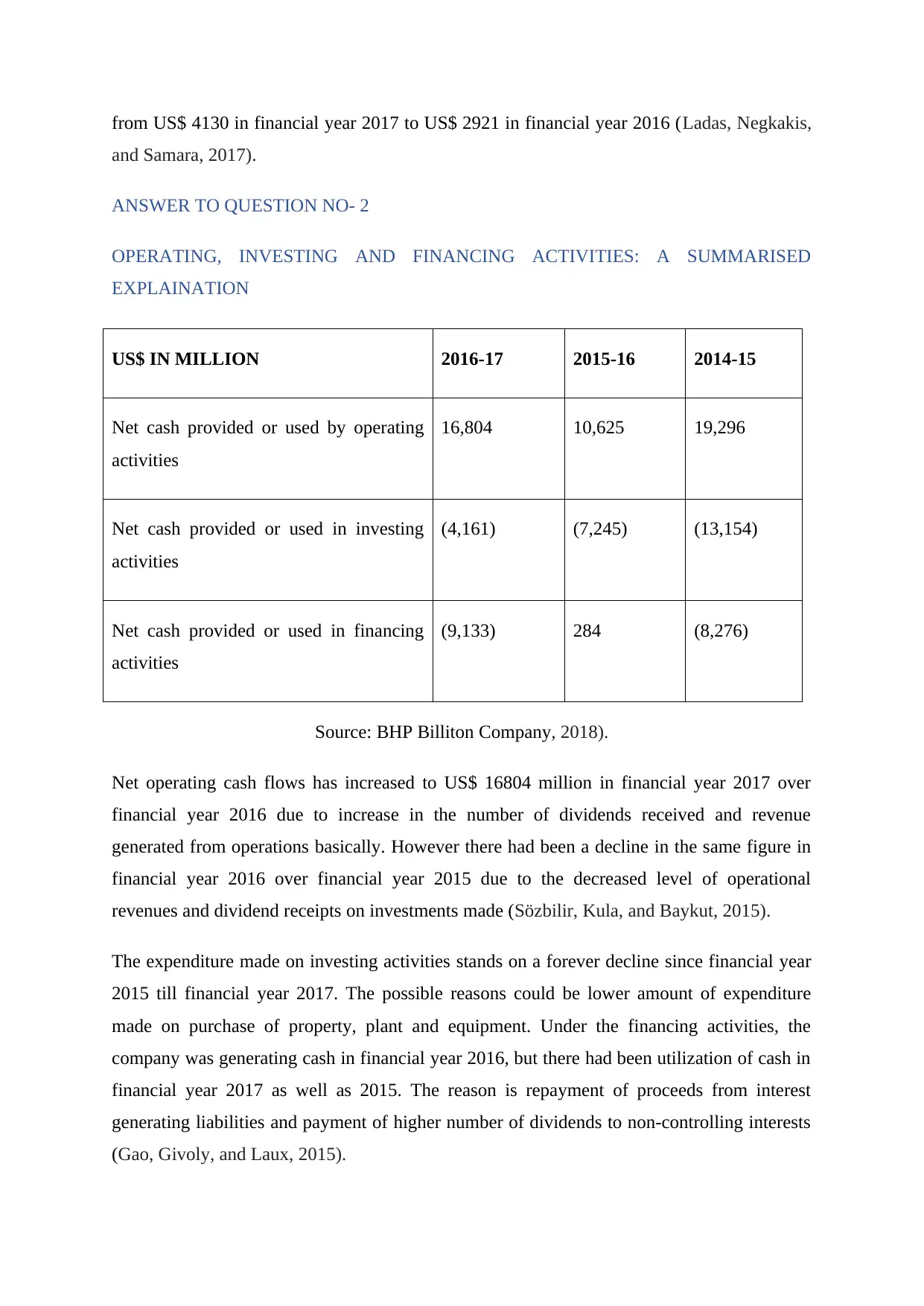
from US$ 4130 in financial year 2017 to US$ 2921 in financial year 2016 (Ladas, Negkakis,
and Samara, 2017).
ANSWER TO QUESTION NO- 2
OPERATING, INVESTING AND FINANCING ACTIVITIES: A SUMMARISED
EXPLAINATION
US$ IN MILLION 2016-17 2015-16 2014-15
Net cash provided or used by operating
activities
16,804 10,625 19,296
Net cash provided or used in investing
activities
(4,161) (7,245) (13,154)
Net cash provided or used in financing
activities
(9,133) 284 (8,276)
Source: BHP Billiton Company, 2018).
Net operating cash flows has increased to US$ 16804 million in financial year 2017 over
financial year 2016 due to increase in the number of dividends received and revenue
generated from operations basically. However there had been a decline in the same figure in
financial year 2016 over financial year 2015 due to the decreased level of operational
revenues and dividend receipts on investments made (Sözbilir, Kula, and Baykut, 2015).
The expenditure made on investing activities stands on a forever decline since financial year
2015 till financial year 2017. The possible reasons could be lower amount of expenditure
made on purchase of property, plant and equipment. Under the financing activities, the
company was generating cash in financial year 2016, but there had been utilization of cash in
financial year 2017 as well as 2015. The reason is repayment of proceeds from interest
generating liabilities and payment of higher number of dividends to non-controlling interests
(Gao, Givoly, and Laux, 2015).
and Samara, 2017).
ANSWER TO QUESTION NO- 2
OPERATING, INVESTING AND FINANCING ACTIVITIES: A SUMMARISED
EXPLAINATION
US$ IN MILLION 2016-17 2015-16 2014-15
Net cash provided or used by operating
activities
16,804 10,625 19,296
Net cash provided or used in investing
activities
(4,161) (7,245) (13,154)
Net cash provided or used in financing
activities
(9,133) 284 (8,276)
Source: BHP Billiton Company, 2018).
Net operating cash flows has increased to US$ 16804 million in financial year 2017 over
financial year 2016 due to increase in the number of dividends received and revenue
generated from operations basically. However there had been a decline in the same figure in
financial year 2016 over financial year 2015 due to the decreased level of operational
revenues and dividend receipts on investments made (Sözbilir, Kula, and Baykut, 2015).
The expenditure made on investing activities stands on a forever decline since financial year
2015 till financial year 2017. The possible reasons could be lower amount of expenditure
made on purchase of property, plant and equipment. Under the financing activities, the
company was generating cash in financial year 2016, but there had been utilization of cash in
financial year 2017 as well as 2015. The reason is repayment of proceeds from interest
generating liabilities and payment of higher number of dividends to non-controlling interests
(Gao, Givoly, and Laux, 2015).
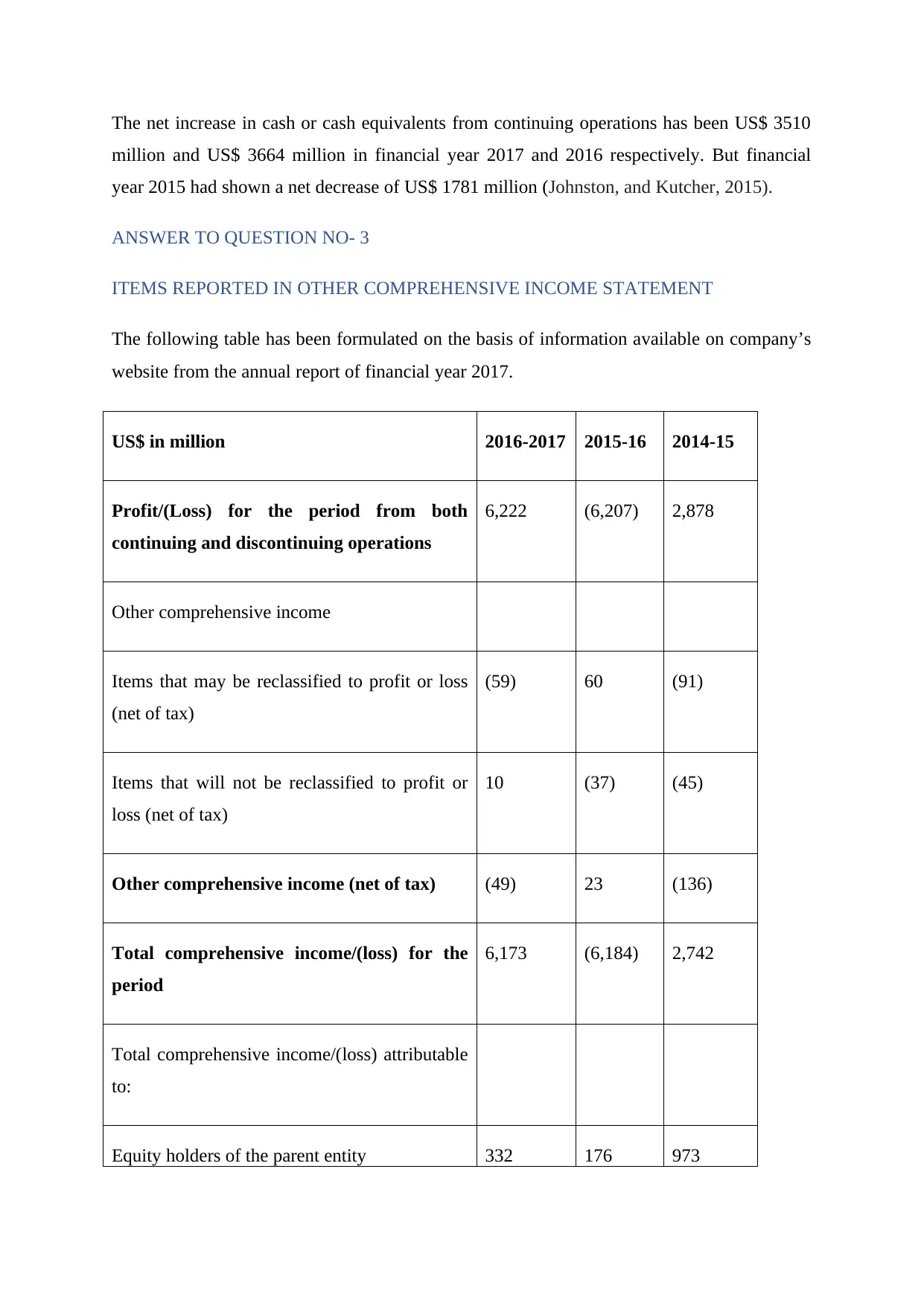
The net increase in cash or cash equivalents from continuing operations has been US$ 3510
million and US$ 3664 million in financial year 2017 and 2016 respectively. But financial
year 2015 had shown a net decrease of US$ 1781 million (Johnston, and Kutcher, 2015).
ANSWER TO QUESTION NO- 3
ITEMS REPORTED IN OTHER COMPREHENSIVE INCOME STATEMENT
The following table has been formulated on the basis of information available on company’s
website from the annual report of financial year 2017.
US$ in million 2016-2017 2015-16 2014-15
Profit/(Loss) for the period from both
continuing and discontinuing operations
6,222 (6,207) 2,878
Other comprehensive income
Items that may be reclassified to profit or loss
(net of tax)
(59) 60 (91)
Items that will not be reclassified to profit or
loss (net of tax)
10 (37) (45)
Other comprehensive income (net of tax) (49) 23 (136)
Total comprehensive income/(loss) for the
period
6,173 (6,184) 2,742
Total comprehensive income/(loss) attributable
to:
Equity holders of the parent entity 332 176 973
million and US$ 3664 million in financial year 2017 and 2016 respectively. But financial
year 2015 had shown a net decrease of US$ 1781 million (Johnston, and Kutcher, 2015).
ANSWER TO QUESTION NO- 3
ITEMS REPORTED IN OTHER COMPREHENSIVE INCOME STATEMENT
The following table has been formulated on the basis of information available on company’s
website from the annual report of financial year 2017.
US$ in million 2016-2017 2015-16 2014-15
Profit/(Loss) for the period from both
continuing and discontinuing operations
6,222 (6,207) 2,878
Other comprehensive income
Items that may be reclassified to profit or loss
(net of tax)
(59) 60 (91)
Items that will not be reclassified to profit or
loss (net of tax)
10 (37) (45)
Other comprehensive income (net of tax) (49) 23 (136)
Total comprehensive income/(loss) for the
period
6,173 (6,184) 2,742
Total comprehensive income/(loss) attributable
to:
Equity holders of the parent entity 332 176 973
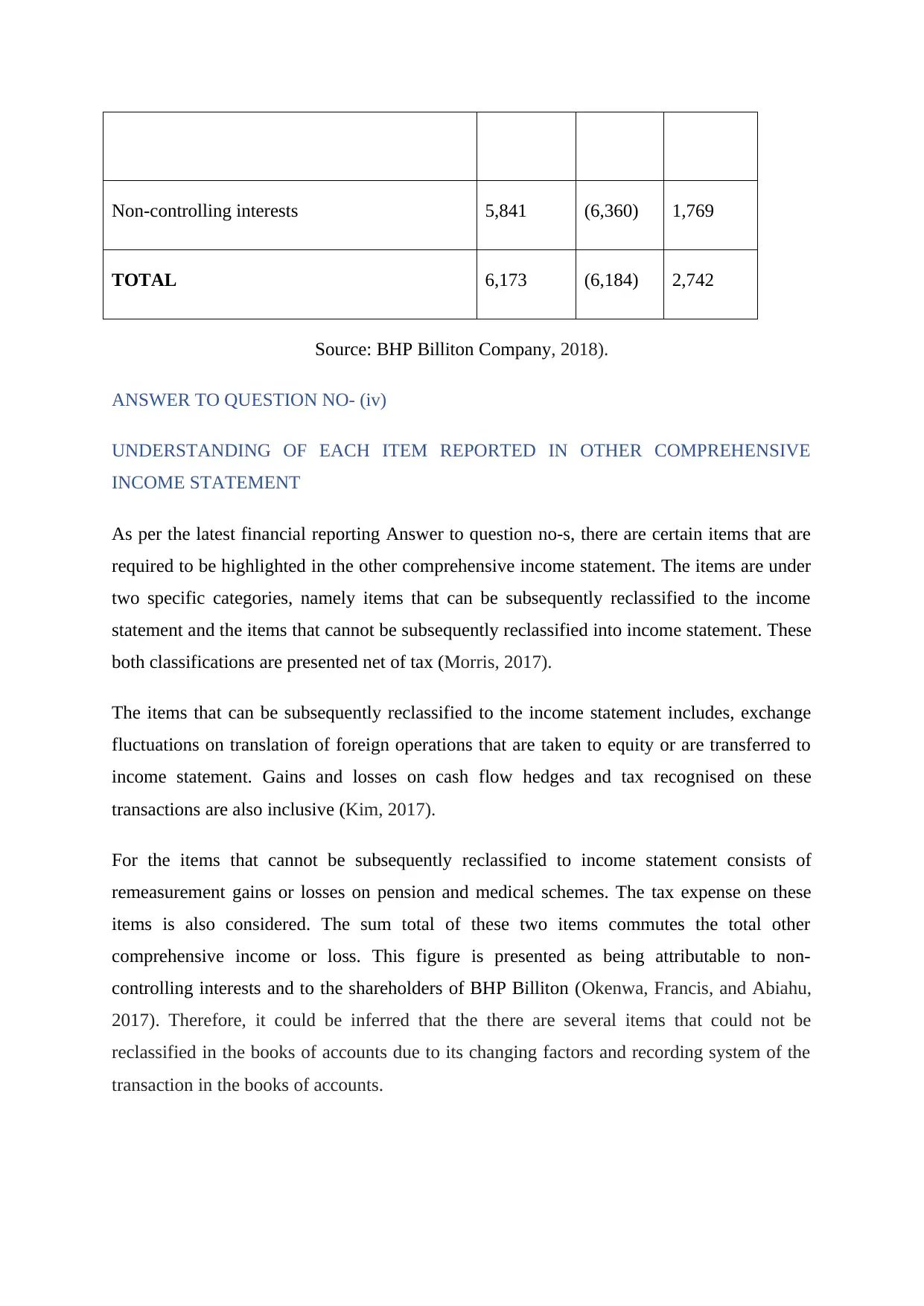
Non-controlling interests 5,841 (6,360) 1,769
TOTAL 6,173 (6,184) 2,742
Source: BHP Billiton Company, 2018).
ANSWER TO QUESTION NO- (iv)
UNDERSTANDING OF EACH ITEM REPORTED IN OTHER COMPREHENSIVE
INCOME STATEMENT
As per the latest financial reporting Answer to question no-s, there are certain items that are
required to be highlighted in the other comprehensive income statement. The items are under
two specific categories, namely items that can be subsequently reclassified to the income
statement and the items that cannot be subsequently reclassified into income statement. These
both classifications are presented net of tax (Morris, 2017).
The items that can be subsequently reclassified to the income statement includes, exchange
fluctuations on translation of foreign operations that are taken to equity or are transferred to
income statement. Gains and losses on cash flow hedges and tax recognised on these
transactions are also inclusive (Kim, 2017).
For the items that cannot be subsequently reclassified to income statement consists of
remeasurement gains or losses on pension and medical schemes. The tax expense on these
items is also considered. The sum total of these two items commutes the total other
comprehensive income or loss. This figure is presented as being attributable to non-
controlling interests and to the shareholders of BHP Billiton (Okenwa, Francis, and Abiahu,
2017). Therefore, it could be inferred that the there are several items that could not be
reclassified in the books of accounts due to its changing factors and recording system of the
transaction in the books of accounts.
TOTAL 6,173 (6,184) 2,742
Source: BHP Billiton Company, 2018).
ANSWER TO QUESTION NO- (iv)
UNDERSTANDING OF EACH ITEM REPORTED IN OTHER COMPREHENSIVE
INCOME STATEMENT
As per the latest financial reporting Answer to question no-s, there are certain items that are
required to be highlighted in the other comprehensive income statement. The items are under
two specific categories, namely items that can be subsequently reclassified to the income
statement and the items that cannot be subsequently reclassified into income statement. These
both classifications are presented net of tax (Morris, 2017).
The items that can be subsequently reclassified to the income statement includes, exchange
fluctuations on translation of foreign operations that are taken to equity or are transferred to
income statement. Gains and losses on cash flow hedges and tax recognised on these
transactions are also inclusive (Kim, 2017).
For the items that cannot be subsequently reclassified to income statement consists of
remeasurement gains or losses on pension and medical schemes. The tax expense on these
items is also considered. The sum total of these two items commutes the total other
comprehensive income or loss. This figure is presented as being attributable to non-
controlling interests and to the shareholders of BHP Billiton (Okenwa, Francis, and Abiahu,
2017). Therefore, it could be inferred that the there are several items that could not be
reclassified in the books of accounts due to its changing factors and recording system of the
transaction in the books of accounts.
Paraphrase This Document
Need a fresh take? Get an instant paraphrase of this document with our AI Paraphraser
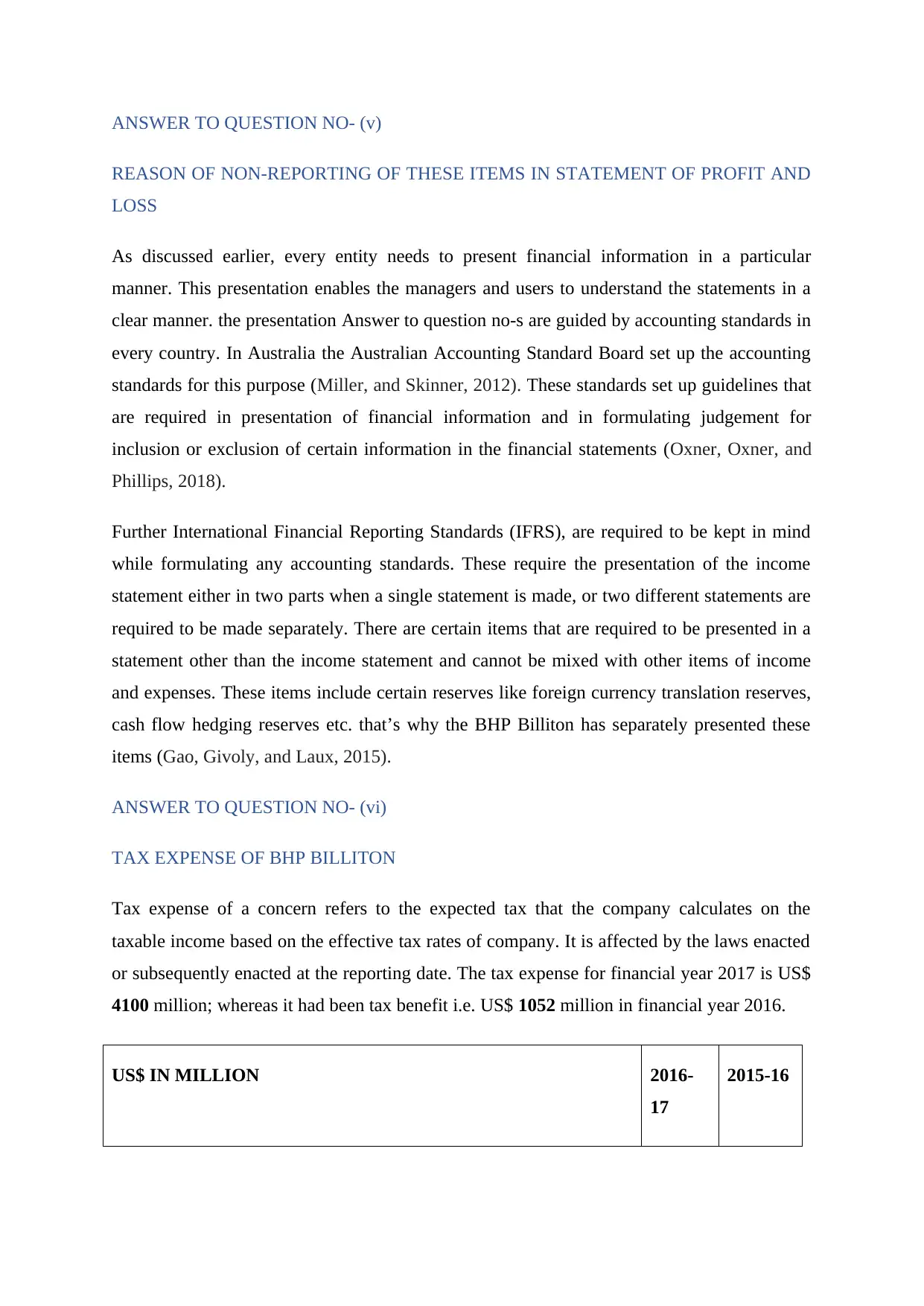
ANSWER TO QUESTION NO- (v)
REASON OF NON-REPORTING OF THESE ITEMS IN STATEMENT OF PROFIT AND
LOSS
As discussed earlier, every entity needs to present financial information in a particular
manner. This presentation enables the managers and users to understand the statements in a
clear manner. the presentation Answer to question no-s are guided by accounting standards in
every country. In Australia the Australian Accounting Standard Board set up the accounting
standards for this purpose (Miller, and Skinner, 2012). These standards set up guidelines that
are required in presentation of financial information and in formulating judgement for
inclusion or exclusion of certain information in the financial statements (Oxner, Oxner, and
Phillips, 2018).
Further International Financial Reporting Standards (IFRS), are required to be kept in mind
while formulating any accounting standards. These require the presentation of the income
statement either in two parts when a single statement is made, or two different statements are
required to be made separately. There are certain items that are required to be presented in a
statement other than the income statement and cannot be mixed with other items of income
and expenses. These items include certain reserves like foreign currency translation reserves,
cash flow hedging reserves etc. that’s why the BHP Billiton has separately presented these
items (Gao, Givoly, and Laux, 2015).
ANSWER TO QUESTION NO- (vi)
TAX EXPENSE OF BHP BILLITON
Tax expense of a concern refers to the expected tax that the company calculates on the
taxable income based on the effective tax rates of company. It is affected by the laws enacted
or subsequently enacted at the reporting date. The tax expense for financial year 2017 is US$
4100 million; whereas it had been tax benefit i.e. US$ 1052 million in financial year 2016.
US$ IN MILLION 2016-
17
2015-16
REASON OF NON-REPORTING OF THESE ITEMS IN STATEMENT OF PROFIT AND
LOSS
As discussed earlier, every entity needs to present financial information in a particular
manner. This presentation enables the managers and users to understand the statements in a
clear manner. the presentation Answer to question no-s are guided by accounting standards in
every country. In Australia the Australian Accounting Standard Board set up the accounting
standards for this purpose (Miller, and Skinner, 2012). These standards set up guidelines that
are required in presentation of financial information and in formulating judgement for
inclusion or exclusion of certain information in the financial statements (Oxner, Oxner, and
Phillips, 2018).
Further International Financial Reporting Standards (IFRS), are required to be kept in mind
while formulating any accounting standards. These require the presentation of the income
statement either in two parts when a single statement is made, or two different statements are
required to be made separately. There are certain items that are required to be presented in a
statement other than the income statement and cannot be mixed with other items of income
and expenses. These items include certain reserves like foreign currency translation reserves,
cash flow hedging reserves etc. that’s why the BHP Billiton has separately presented these
items (Gao, Givoly, and Laux, 2015).
ANSWER TO QUESTION NO- (vi)
TAX EXPENSE OF BHP BILLITON
Tax expense of a concern refers to the expected tax that the company calculates on the
taxable income based on the effective tax rates of company. It is affected by the laws enacted
or subsequently enacted at the reporting date. The tax expense for financial year 2017 is US$
4100 million; whereas it had been tax benefit i.e. US$ 1052 million in financial year 2016.
US$ IN MILLION 2016-
17
2015-16
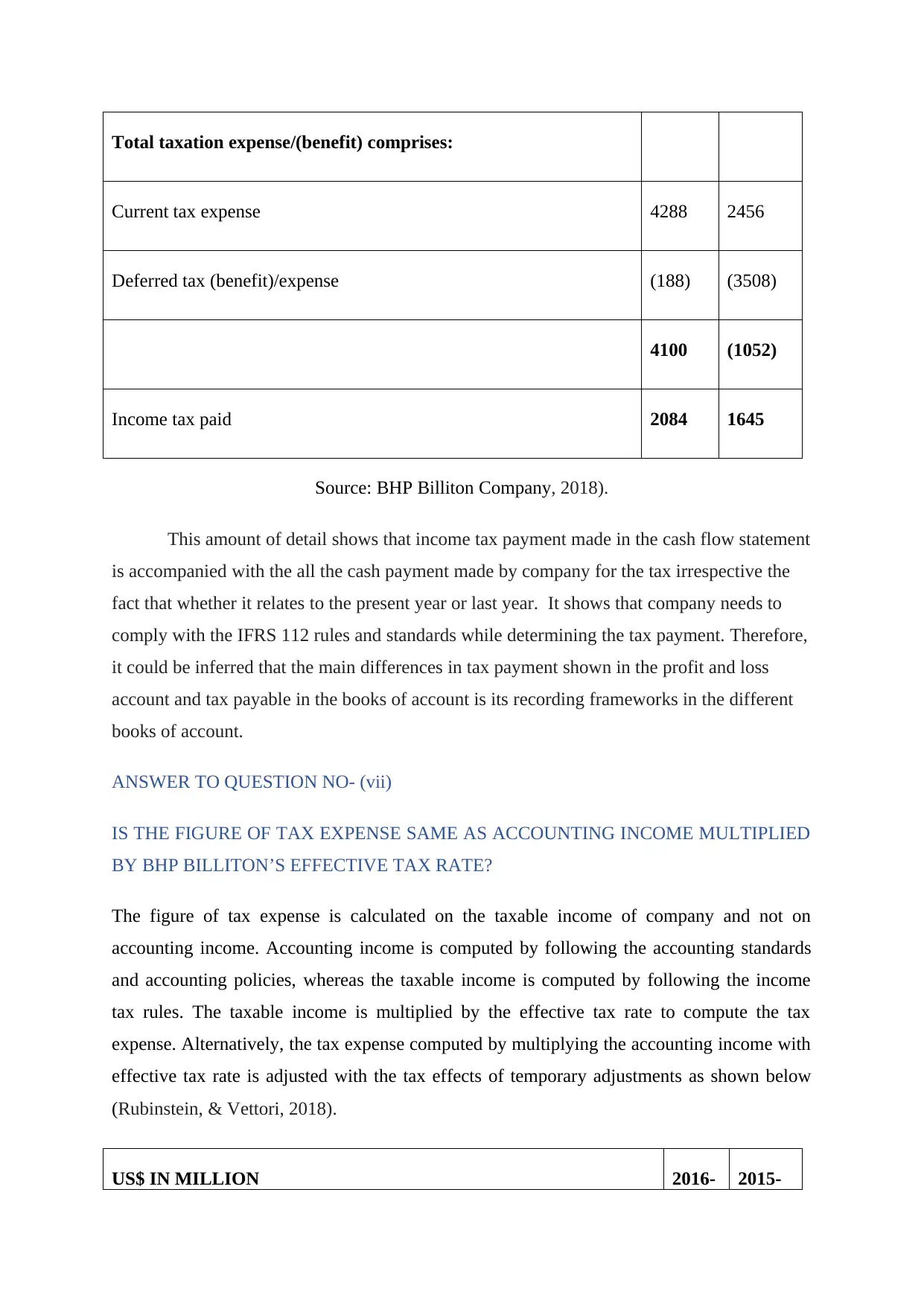
Total taxation expense/(benefit) comprises:
Current tax expense 4288 2456
Deferred tax (benefit)/expense (188) (3508)
4100 (1052)
Income tax paid 2084 1645
Source: BHP Billiton Company, 2018).
This amount of detail shows that income tax payment made in the cash flow statement
is accompanied with the all the cash payment made by company for the tax irrespective the
fact that whether it relates to the present year or last year. It shows that company needs to
comply with the IFRS 112 rules and standards while determining the tax payment. Therefore,
it could be inferred that the main differences in tax payment shown in the profit and loss
account and tax payable in the books of account is its recording frameworks in the different
books of account.
ANSWER TO QUESTION NO- (vii)
IS THE FIGURE OF TAX EXPENSE SAME AS ACCOUNTING INCOME MULTIPLIED
BY BHP BILLITON’S EFFECTIVE TAX RATE?
The figure of tax expense is calculated on the taxable income of company and not on
accounting income. Accounting income is computed by following the accounting standards
and accounting policies, whereas the taxable income is computed by following the income
tax rules. The taxable income is multiplied by the effective tax rate to compute the tax
expense. Alternatively, the tax expense computed by multiplying the accounting income with
effective tax rate is adjusted with the tax effects of temporary adjustments as shown below
(Rubinstein, & Vettori, 2018).
US$ IN MILLION 2016- 2015-
Current tax expense 4288 2456
Deferred tax (benefit)/expense (188) (3508)
4100 (1052)
Income tax paid 2084 1645
Source: BHP Billiton Company, 2018).
This amount of detail shows that income tax payment made in the cash flow statement
is accompanied with the all the cash payment made by company for the tax irrespective the
fact that whether it relates to the present year or last year. It shows that company needs to
comply with the IFRS 112 rules and standards while determining the tax payment. Therefore,
it could be inferred that the main differences in tax payment shown in the profit and loss
account and tax payable in the books of account is its recording frameworks in the different
books of account.
ANSWER TO QUESTION NO- (vii)
IS THE FIGURE OF TAX EXPENSE SAME AS ACCOUNTING INCOME MULTIPLIED
BY BHP BILLITON’S EFFECTIVE TAX RATE?
The figure of tax expense is calculated on the taxable income of company and not on
accounting income. Accounting income is computed by following the accounting standards
and accounting policies, whereas the taxable income is computed by following the income
tax rules. The taxable income is multiplied by the effective tax rate to compute the tax
expense. Alternatively, the tax expense computed by multiplying the accounting income with
effective tax rate is adjusted with the tax effects of temporary adjustments as shown below
(Rubinstein, & Vettori, 2018).
US$ IN MILLION 2016- 2015-
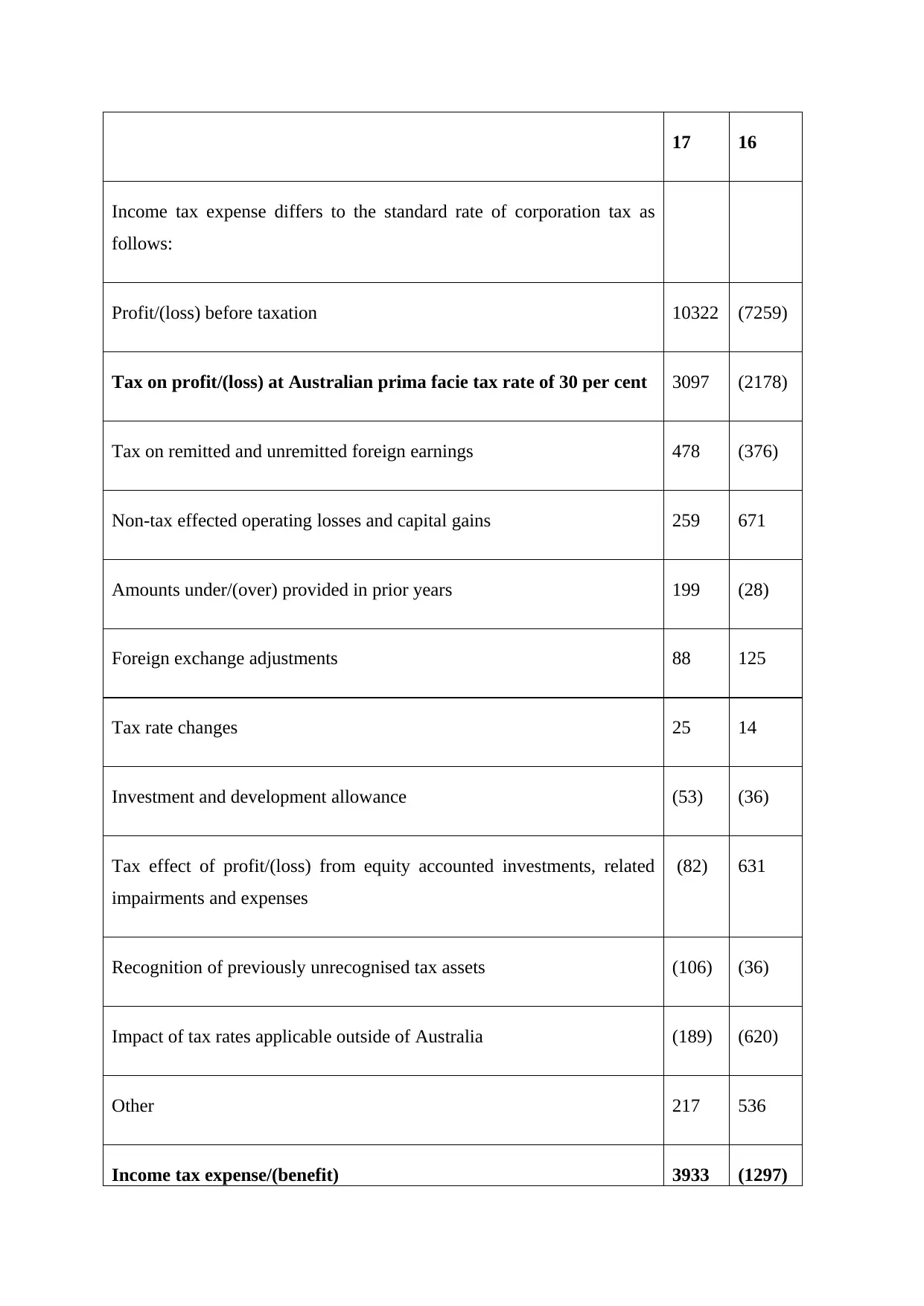
17 16
Income tax expense differs to the standard rate of corporation tax as
follows:
Profit/(loss) before taxation 10322 (7259)
Tax on profit/(loss) at Australian prima facie tax rate of 30 per cent 3097 (2178)
Tax on remitted and unremitted foreign earnings 478 (376)
Non-tax effected operating losses and capital gains 259 671
Amounts under/(over) provided in prior years 199 (28)
Foreign exchange adjustments 88 125
Tax rate changes 25 14
Investment and development allowance (53) (36)
Tax effect of profit/(loss) from equity accounted investments, related
impairments and expenses
(82) 631
Recognition of previously unrecognised tax assets (106) (36)
Impact of tax rates applicable outside of Australia (189) (620)
Other 217 536
Income tax expense/(benefit) 3933 (1297)
Income tax expense differs to the standard rate of corporation tax as
follows:
Profit/(loss) before taxation 10322 (7259)
Tax on profit/(loss) at Australian prima facie tax rate of 30 per cent 3097 (2178)
Tax on remitted and unremitted foreign earnings 478 (376)
Non-tax effected operating losses and capital gains 259 671
Amounts under/(over) provided in prior years 199 (28)
Foreign exchange adjustments 88 125
Tax rate changes 25 14
Investment and development allowance (53) (36)
Tax effect of profit/(loss) from equity accounted investments, related
impairments and expenses
(82) 631
Recognition of previously unrecognised tax assets (106) (36)
Impact of tax rates applicable outside of Australia (189) (620)
Other 217 536
Income tax expense/(benefit) 3933 (1297)
Secure Best Marks with AI Grader
Need help grading? Try our AI Grader for instant feedback on your assignments.
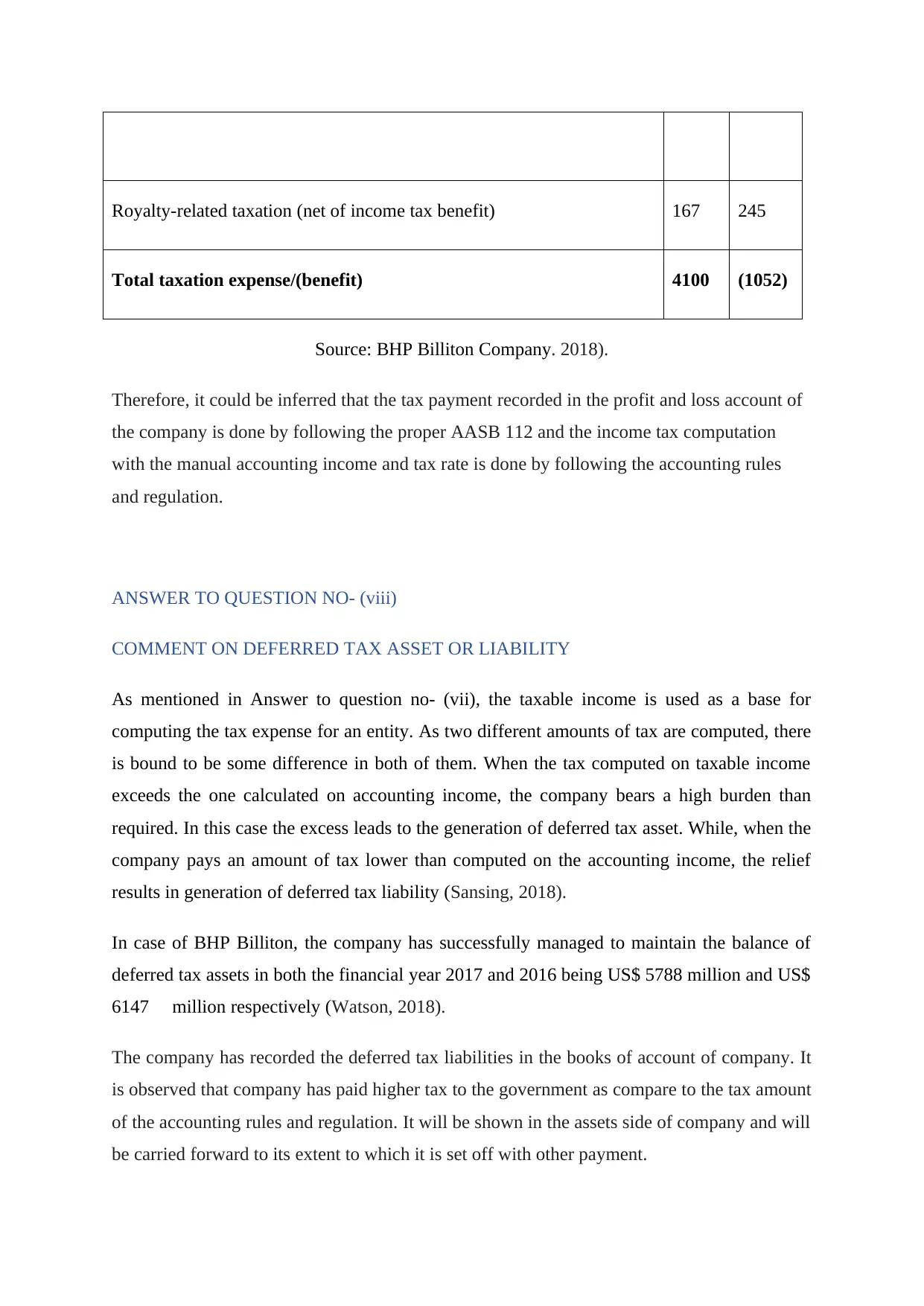
Royalty-related taxation (net of income tax benefit) 167 245
Total taxation expense/(benefit) 4100 (1052)
Source: BHP Billiton Company. 2018).
Therefore, it could be inferred that the tax payment recorded in the profit and loss account of
the company is done by following the proper AASB 112 and the income tax computation
with the manual accounting income and tax rate is done by following the accounting rules
and regulation.
ANSWER TO QUESTION NO- (viii)
COMMENT ON DEFERRED TAX ASSET OR LIABILITY
As mentioned in Answer to question no- (vii), the taxable income is used as a base for
computing the tax expense for an entity. As two different amounts of tax are computed, there
is bound to be some difference in both of them. When the tax computed on taxable income
exceeds the one calculated on accounting income, the company bears a high burden than
required. In this case the excess leads to the generation of deferred tax asset. While, when the
company pays an amount of tax lower than computed on the accounting income, the relief
results in generation of deferred tax liability (Sansing, 2018).
In case of BHP Billiton, the company has successfully managed to maintain the balance of
deferred tax assets in both the financial year 2017 and 2016 being US$ 5788 million and US$
6147 million respectively (Watson, 2018).
The company has recorded the deferred tax liabilities in the books of account of company. It
is observed that company has paid higher tax to the government as compare to the tax amount
of the accounting rules and regulation. It will be shown in the assets side of company and will
be carried forward to its extent to which it is set off with other payment.
Total taxation expense/(benefit) 4100 (1052)
Source: BHP Billiton Company. 2018).
Therefore, it could be inferred that the tax payment recorded in the profit and loss account of
the company is done by following the proper AASB 112 and the income tax computation
with the manual accounting income and tax rate is done by following the accounting rules
and regulation.
ANSWER TO QUESTION NO- (viii)
COMMENT ON DEFERRED TAX ASSET OR LIABILITY
As mentioned in Answer to question no- (vii), the taxable income is used as a base for
computing the tax expense for an entity. As two different amounts of tax are computed, there
is bound to be some difference in both of them. When the tax computed on taxable income
exceeds the one calculated on accounting income, the company bears a high burden than
required. In this case the excess leads to the generation of deferred tax asset. While, when the
company pays an amount of tax lower than computed on the accounting income, the relief
results in generation of deferred tax liability (Sansing, 2018).
In case of BHP Billiton, the company has successfully managed to maintain the balance of
deferred tax assets in both the financial year 2017 and 2016 being US$ 5788 million and US$
6147 million respectively (Watson, 2018).
The company has recorded the deferred tax liabilities in the books of account of company. It
is observed that company has paid higher tax to the government as compare to the tax amount
of the accounting rules and regulation. It will be shown in the assets side of company and will
be carried forward to its extent to which it is set off with other payment.
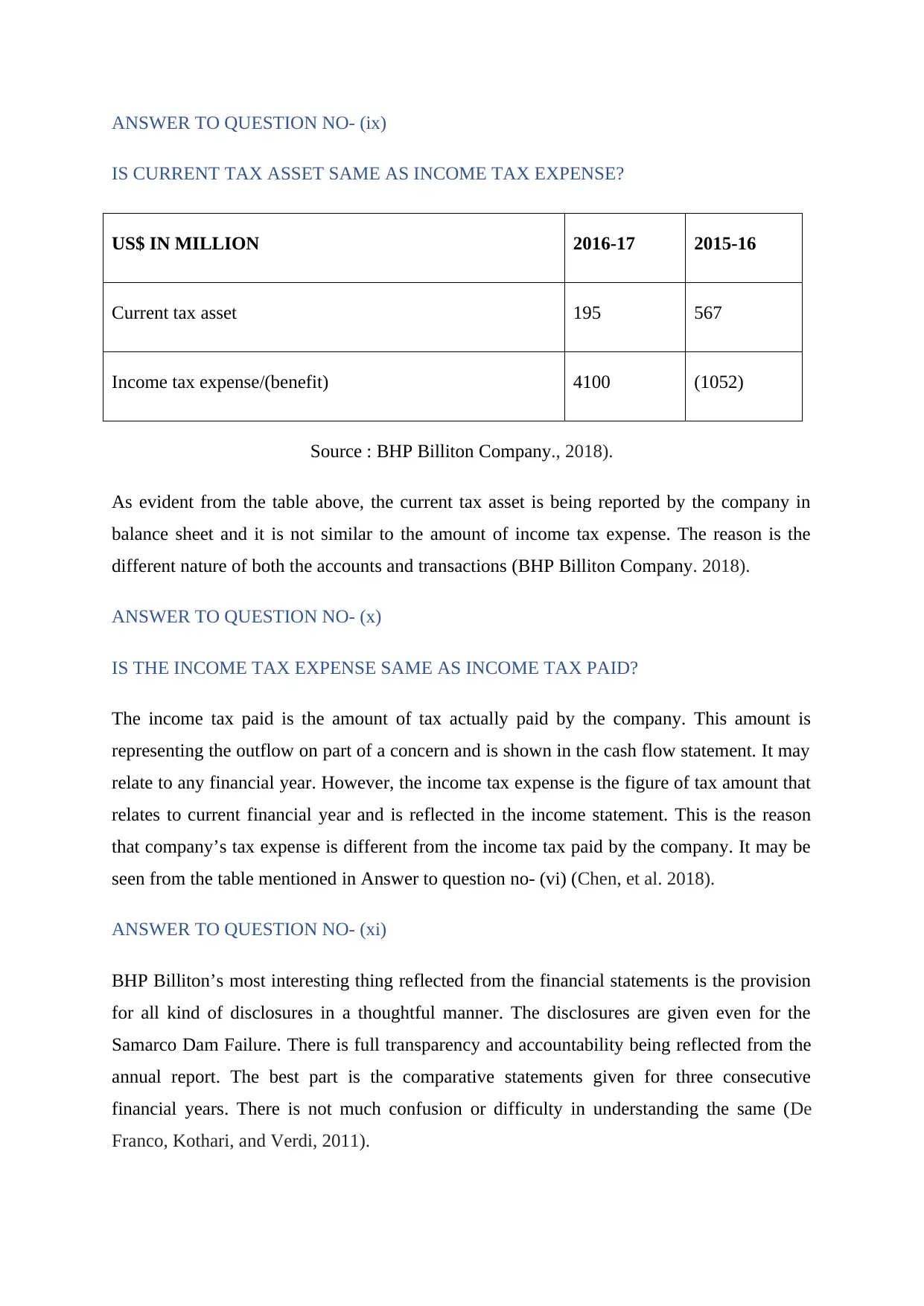
ANSWER TO QUESTION NO- (ix)
IS CURRENT TAX ASSET SAME AS INCOME TAX EXPENSE?
US$ IN MILLION 2016-17 2015-16
Current tax asset 195 567
Income tax expense/(benefit) 4100 (1052)
Source : BHP Billiton Company., 2018).
As evident from the table above, the current tax asset is being reported by the company in
balance sheet and it is not similar to the amount of income tax expense. The reason is the
different nature of both the accounts and transactions (BHP Billiton Company. 2018).
ANSWER TO QUESTION NO- (x)
IS THE INCOME TAX EXPENSE SAME AS INCOME TAX PAID?
The income tax paid is the amount of tax actually paid by the company. This amount is
representing the outflow on part of a concern and is shown in the cash flow statement. It may
relate to any financial year. However, the income tax expense is the figure of tax amount that
relates to current financial year and is reflected in the income statement. This is the reason
that company’s tax expense is different from the income tax paid by the company. It may be
seen from the table mentioned in Answer to question no- (vi) (Chen, et al. 2018).
ANSWER TO QUESTION NO- (xi)
BHP Billiton’s most interesting thing reflected from the financial statements is the provision
for all kind of disclosures in a thoughtful manner. The disclosures are given even for the
Samarco Dam Failure. There is full transparency and accountability being reflected from the
annual report. The best part is the comparative statements given for three consecutive
financial years. There is not much confusion or difficulty in understanding the same (De
Franco, Kothari, and Verdi, 2011).
IS CURRENT TAX ASSET SAME AS INCOME TAX EXPENSE?
US$ IN MILLION 2016-17 2015-16
Current tax asset 195 567
Income tax expense/(benefit) 4100 (1052)
Source : BHP Billiton Company., 2018).
As evident from the table above, the current tax asset is being reported by the company in
balance sheet and it is not similar to the amount of income tax expense. The reason is the
different nature of both the accounts and transactions (BHP Billiton Company. 2018).
ANSWER TO QUESTION NO- (x)
IS THE INCOME TAX EXPENSE SAME AS INCOME TAX PAID?
The income tax paid is the amount of tax actually paid by the company. This amount is
representing the outflow on part of a concern and is shown in the cash flow statement. It may
relate to any financial year. However, the income tax expense is the figure of tax amount that
relates to current financial year and is reflected in the income statement. This is the reason
that company’s tax expense is different from the income tax paid by the company. It may be
seen from the table mentioned in Answer to question no- (vi) (Chen, et al. 2018).
ANSWER TO QUESTION NO- (xi)
BHP Billiton’s most interesting thing reflected from the financial statements is the provision
for all kind of disclosures in a thoughtful manner. The disclosures are given even for the
Samarco Dam Failure. There is full transparency and accountability being reflected from the
annual report. The best part is the comparative statements given for three consecutive
financial years. There is not much confusion or difficulty in understanding the same (De
Franco, Kothari, and Verdi, 2011).
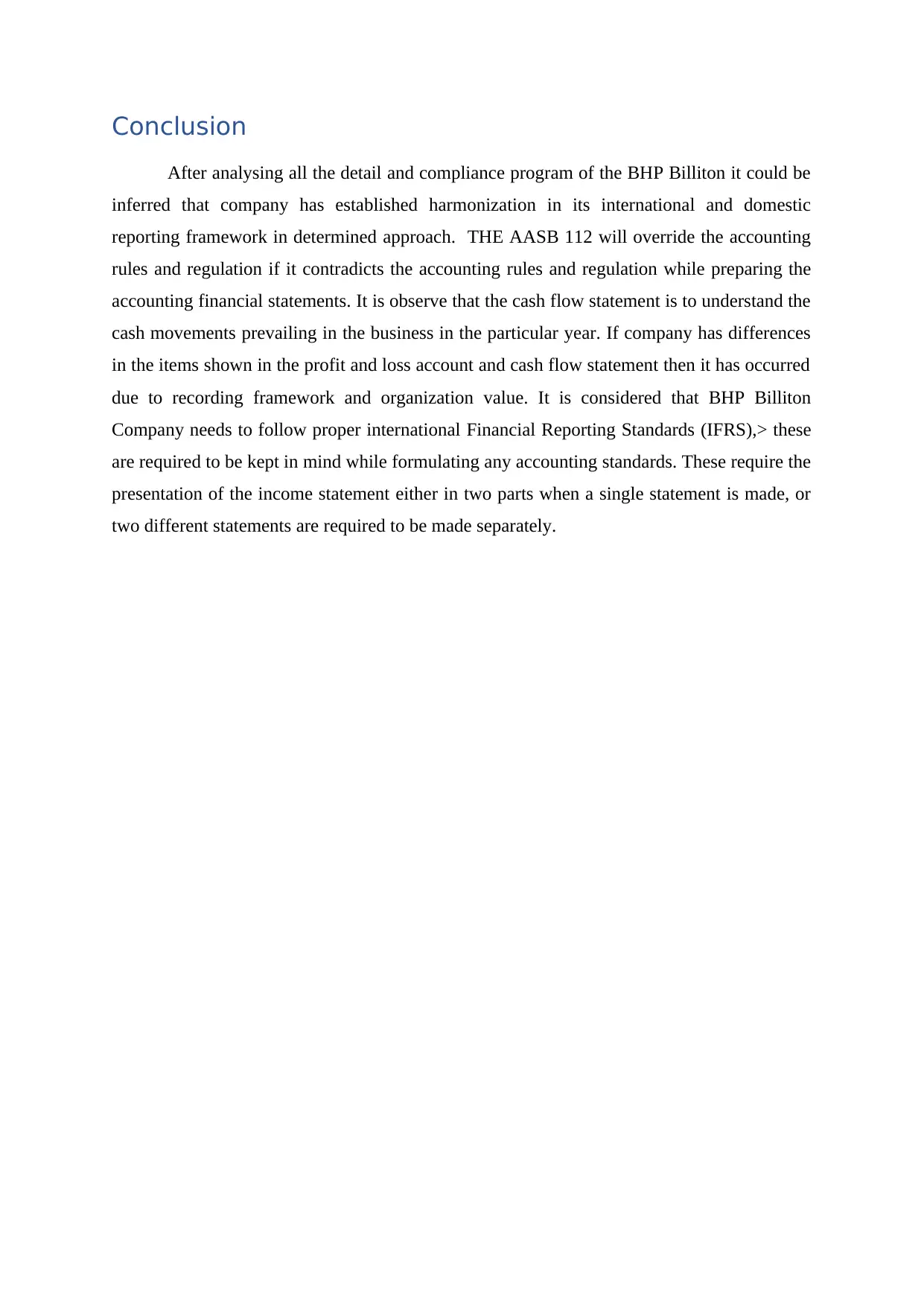
Conclusion
After analysing all the detail and compliance program of the BHP Billiton it could be
inferred that company has established harmonization in its international and domestic
reporting framework in determined approach. THE AASB 112 will override the accounting
rules and regulation if it contradicts the accounting rules and regulation while preparing the
accounting financial statements. It is observe that the cash flow statement is to understand the
cash movements prevailing in the business in the particular year. If company has differences
in the items shown in the profit and loss account and cash flow statement then it has occurred
due to recording framework and organization value. It is considered that BHP Billiton
Company needs to follow proper international Financial Reporting Standards (IFRS),> these
are required to be kept in mind while formulating any accounting standards. These require the
presentation of the income statement either in two parts when a single statement is made, or
two different statements are required to be made separately.
After analysing all the detail and compliance program of the BHP Billiton it could be
inferred that company has established harmonization in its international and domestic
reporting framework in determined approach. THE AASB 112 will override the accounting
rules and regulation if it contradicts the accounting rules and regulation while preparing the
accounting financial statements. It is observe that the cash flow statement is to understand the
cash movements prevailing in the business in the particular year. If company has differences
in the items shown in the profit and loss account and cash flow statement then it has occurred
due to recording framework and organization value. It is considered that BHP Billiton
Company needs to follow proper international Financial Reporting Standards (IFRS),> these
are required to be kept in mind while formulating any accounting standards. These require the
presentation of the income statement either in two parts when a single statement is made, or
two different statements are required to be made separately.
Paraphrase This Document
Need a fresh take? Get an instant paraphrase of this document with our AI Paraphraser
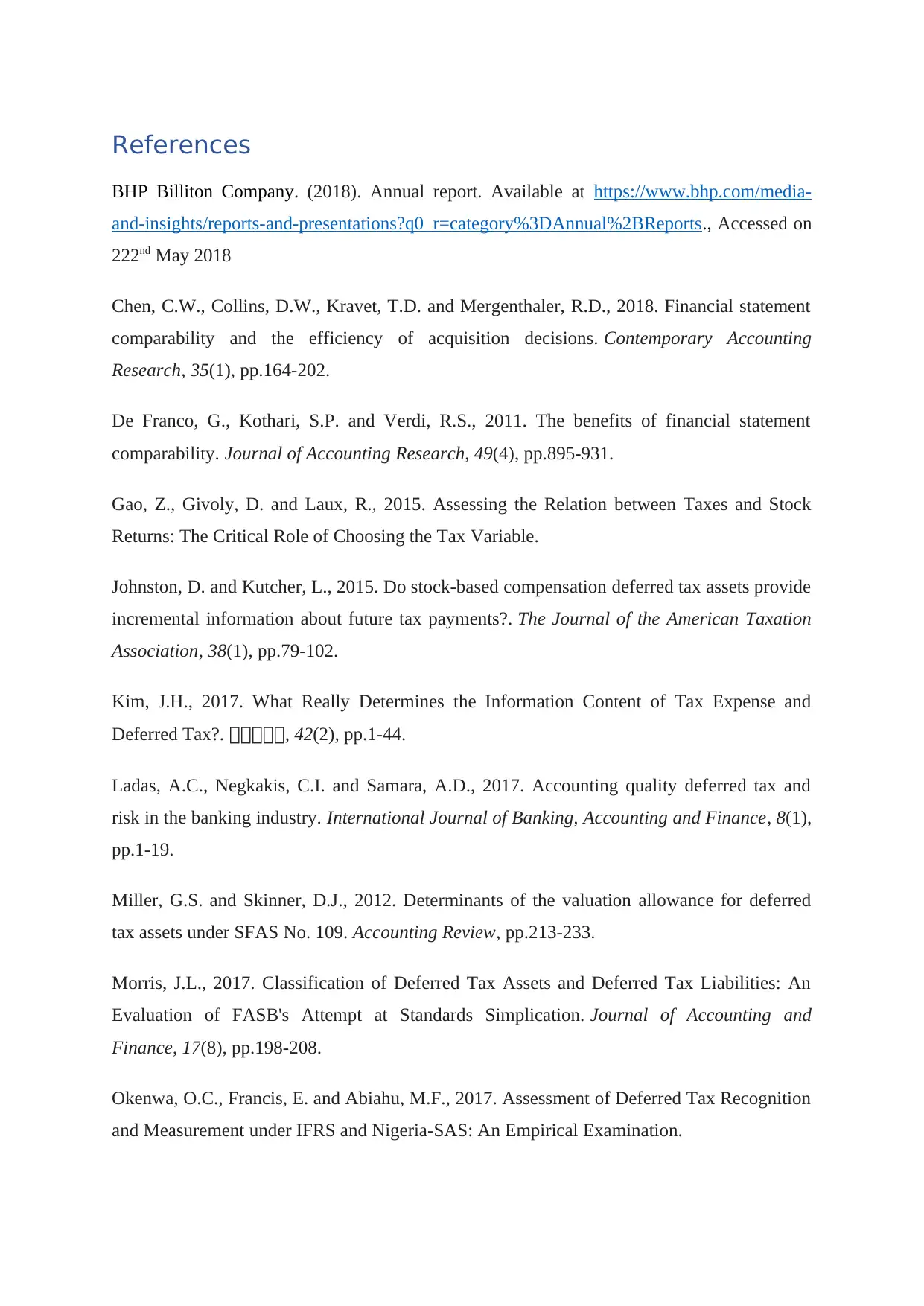
References
BHP Billiton Company. (2018). Annual report. Available at https://www.bhp.com/media-
and-insights/reports-and-presentations?q0_r=category%3DAnnual%2BReports., Accessed on
222nd May 2018
Chen, C.W., Collins, D.W., Kravet, T.D. and Mergenthaler, R.D., 2018. Financial statement
comparability and the efficiency of acquisition decisions. Contemporary Accounting
Research, 35(1), pp.164-202.
De Franco, G., Kothari, S.P. and Verdi, R.S., 2011. The benefits of financial statement
comparability. Journal of Accounting Research, 49(4), pp.895-931.
Gao, Z., Givoly, D. and Laux, R., 2015. Assessing the Relation between Taxes and Stock
Returns: The Critical Role of Choosing the Tax Variable.
Johnston, D. and Kutcher, L., 2015. Do stock-based compensation deferred tax assets provide
incremental information about future tax payments?. The Journal of the American Taxation
Association, 38(1), pp.79-102.
Kim, J.H., 2017. What Really Determines the Information Content of Tax Expense and
Deferred Tax?. 회회회회회, 42(2), pp.1-44.
Ladas, A.C., Negkakis, C.I. and Samara, A.D., 2017. Accounting quality deferred tax and
risk in the banking industry. International Journal of Banking, Accounting and Finance, 8(1),
pp.1-19.
Miller, G.S. and Skinner, D.J., 2012. Determinants of the valuation allowance for deferred
tax assets under SFAS No. 109. Accounting Review, pp.213-233.
Morris, J.L., 2017. Classification of Deferred Tax Assets and Deferred Tax Liabilities: An
Evaluation of FASB's Attempt at Standards Simplication. Journal of Accounting and
Finance, 17(8), pp.198-208.
Okenwa, O.C., Francis, E. and Abiahu, M.F., 2017. Assessment of Deferred Tax Recognition
and Measurement under IFRS and Nigeria-SAS: An Empirical Examination.
BHP Billiton Company. (2018). Annual report. Available at https://www.bhp.com/media-
and-insights/reports-and-presentations?q0_r=category%3DAnnual%2BReports., Accessed on
222nd May 2018
Chen, C.W., Collins, D.W., Kravet, T.D. and Mergenthaler, R.D., 2018. Financial statement
comparability and the efficiency of acquisition decisions. Contemporary Accounting
Research, 35(1), pp.164-202.
De Franco, G., Kothari, S.P. and Verdi, R.S., 2011. The benefits of financial statement
comparability. Journal of Accounting Research, 49(4), pp.895-931.
Gao, Z., Givoly, D. and Laux, R., 2015. Assessing the Relation between Taxes and Stock
Returns: The Critical Role of Choosing the Tax Variable.
Johnston, D. and Kutcher, L., 2015. Do stock-based compensation deferred tax assets provide
incremental information about future tax payments?. The Journal of the American Taxation
Association, 38(1), pp.79-102.
Kim, J.H., 2017. What Really Determines the Information Content of Tax Expense and
Deferred Tax?. 회회회회회, 42(2), pp.1-44.
Ladas, A.C., Negkakis, C.I. and Samara, A.D., 2017. Accounting quality deferred tax and
risk in the banking industry. International Journal of Banking, Accounting and Finance, 8(1),
pp.1-19.
Miller, G.S. and Skinner, D.J., 2012. Determinants of the valuation allowance for deferred
tax assets under SFAS No. 109. Accounting Review, pp.213-233.
Morris, J.L., 2017. Classification of Deferred Tax Assets and Deferred Tax Liabilities: An
Evaluation of FASB's Attempt at Standards Simplication. Journal of Accounting and
Finance, 17(8), pp.198-208.
Okenwa, O.C., Francis, E. and Abiahu, M.F., 2017. Assessment of Deferred Tax Recognition
and Measurement under IFRS and Nigeria-SAS: An Empirical Examination.
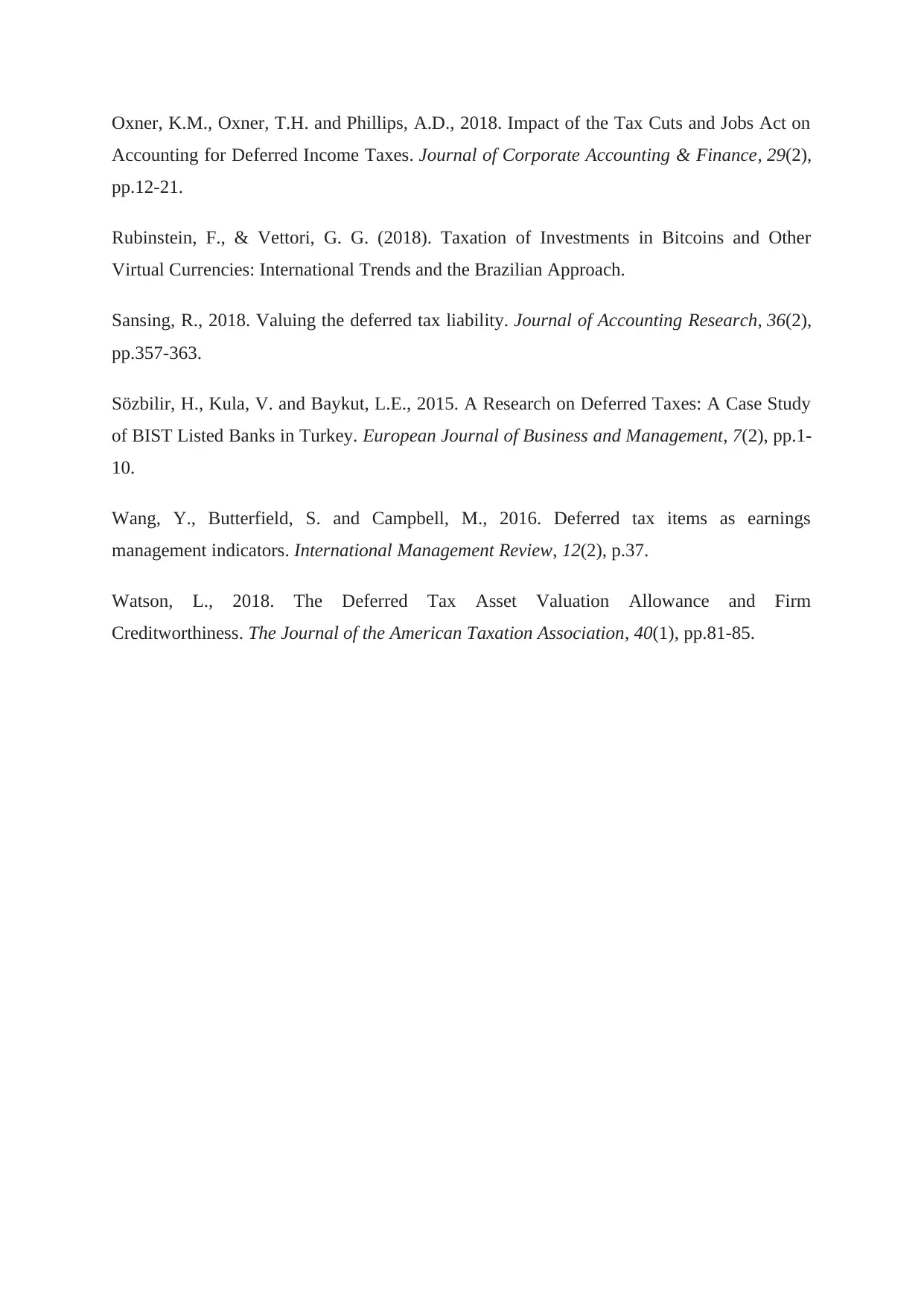
Oxner, K.M., Oxner, T.H. and Phillips, A.D., 2018. Impact of the Tax Cuts and Jobs Act on
Accounting for Deferred Income Taxes. Journal of Corporate Accounting & Finance, 29(2),
pp.12-21.
Rubinstein, F., & Vettori, G. G. (2018). Taxation of Investments in Bitcoins and Other
Virtual Currencies: International Trends and the Brazilian Approach.
Sansing, R., 2018. Valuing the deferred tax liability. Journal of Accounting Research, 36(2),
pp.357-363.
Sözbilir, H., Kula, V. and Baykut, L.E., 2015. A Research on Deferred Taxes: A Case Study
of BIST Listed Banks in Turkey. European Journal of Business and Management, 7(2), pp.1-
10.
Wang, Y., Butterfield, S. and Campbell, M., 2016. Deferred tax items as earnings
management indicators. International Management Review, 12(2), p.37.
Watson, L., 2018. The Deferred Tax Asset Valuation Allowance and Firm
Creditworthiness. The Journal of the American Taxation Association, 40(1), pp.81-85.
Accounting for Deferred Income Taxes. Journal of Corporate Accounting & Finance, 29(2),
pp.12-21.
Rubinstein, F., & Vettori, G. G. (2018). Taxation of Investments in Bitcoins and Other
Virtual Currencies: International Trends and the Brazilian Approach.
Sansing, R., 2018. Valuing the deferred tax liability. Journal of Accounting Research, 36(2),
pp.357-363.
Sözbilir, H., Kula, V. and Baykut, L.E., 2015. A Research on Deferred Taxes: A Case Study
of BIST Listed Banks in Turkey. European Journal of Business and Management, 7(2), pp.1-
10.
Wang, Y., Butterfield, S. and Campbell, M., 2016. Deferred tax items as earnings
management indicators. International Management Review, 12(2), p.37.
Watson, L., 2018. The Deferred Tax Asset Valuation Allowance and Firm
Creditworthiness. The Journal of the American Taxation Association, 40(1), pp.81-85.
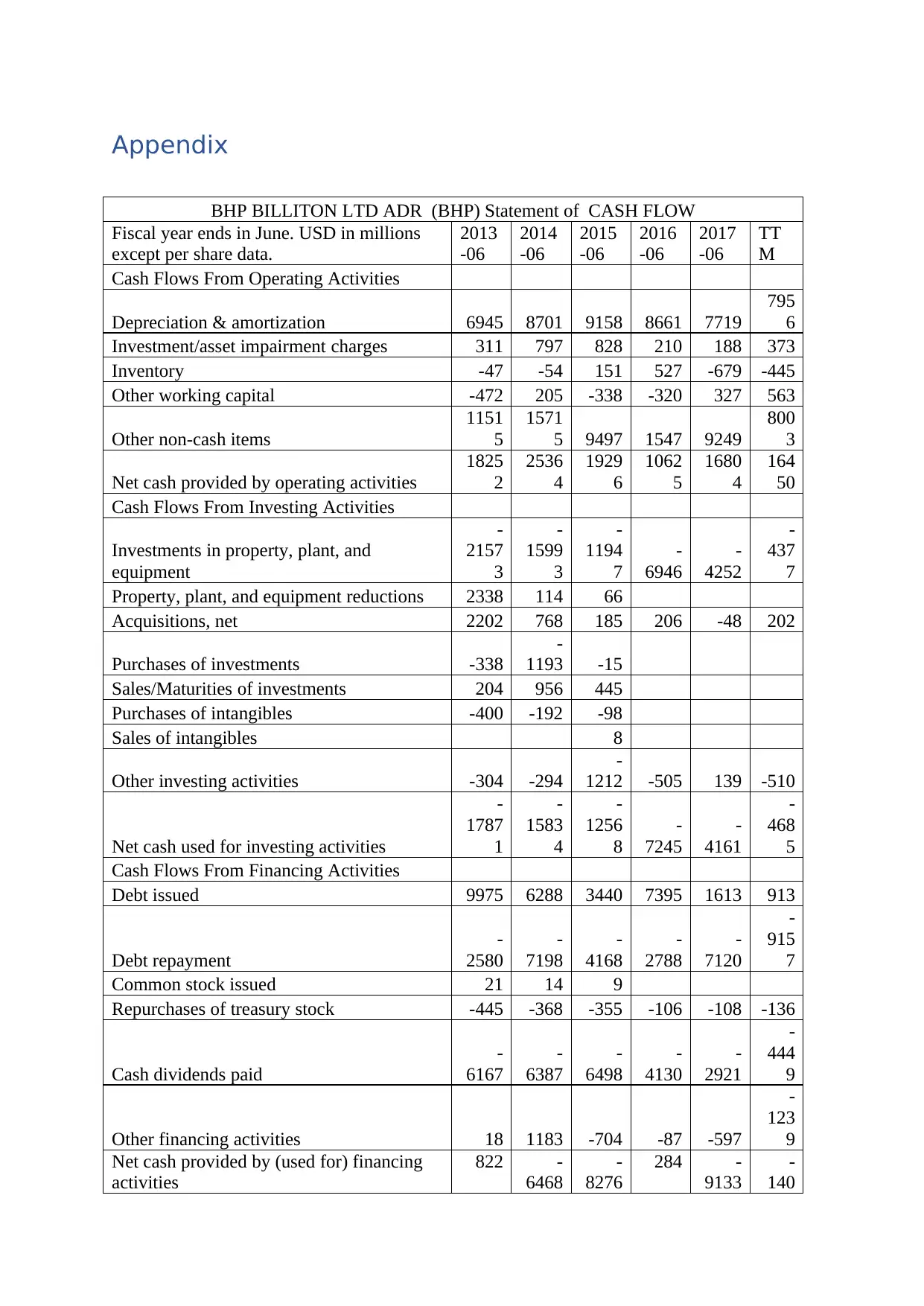
Appendix
BHP BILLITON LTD ADR (BHP) Statement of CASH FLOW
Fiscal year ends in June. USD in millions
except per share data.
2013
-06
2014
-06
2015
-06
2016
-06
2017
-06
TT
M
Cash Flows From Operating Activities
Depreciation & amortization 6945 8701 9158 8661 7719
795
6
Investment/asset impairment charges 311 797 828 210 188 373
Inventory -47 -54 151 527 -679 -445
Other working capital -472 205 -338 -320 327 563
Other non-cash items
1151
5
1571
5 9497 1547 9249
800
3
Net cash provided by operating activities
1825
2
2536
4
1929
6
1062
5
1680
4
164
50
Cash Flows From Investing Activities
Investments in property, plant, and
equipment
-
2157
3
-
1599
3
-
1194
7
-
6946
-
4252
-
437
7
Property, plant, and equipment reductions 2338 114 66
Acquisitions, net 2202 768 185 206 -48 202
Purchases of investments -338
-
1193 -15
Sales/Maturities of investments 204 956 445
Purchases of intangibles -400 -192 -98
Sales of intangibles 8
Other investing activities -304 -294
-
1212 -505 139 -510
Net cash used for investing activities
-
1787
1
-
1583
4
-
1256
8
-
7245
-
4161
-
468
5
Cash Flows From Financing Activities
Debt issued 9975 6288 3440 7395 1613 913
Debt repayment
-
2580
-
7198
-
4168
-
2788
-
7120
-
915
7
Common stock issued 21 14 9
Repurchases of treasury stock -445 -368 -355 -106 -108 -136
Cash dividends paid
-
6167
-
6387
-
6498
-
4130
-
2921
-
444
9
Other financing activities 18 1183 -704 -87 -597
-
123
9
Net cash provided by (used for) financing
activities
822 -
6468
-
8276
284 -
9133
-
140
BHP BILLITON LTD ADR (BHP) Statement of CASH FLOW
Fiscal year ends in June. USD in millions
except per share data.
2013
-06
2014
-06
2015
-06
2016
-06
2017
-06
TT
M
Cash Flows From Operating Activities
Depreciation & amortization 6945 8701 9158 8661 7719
795
6
Investment/asset impairment charges 311 797 828 210 188 373
Inventory -47 -54 151 527 -679 -445
Other working capital -472 205 -338 -320 327 563
Other non-cash items
1151
5
1571
5 9497 1547 9249
800
3
Net cash provided by operating activities
1825
2
2536
4
1929
6
1062
5
1680
4
164
50
Cash Flows From Investing Activities
Investments in property, plant, and
equipment
-
2157
3
-
1599
3
-
1194
7
-
6946
-
4252
-
437
7
Property, plant, and equipment reductions 2338 114 66
Acquisitions, net 2202 768 185 206 -48 202
Purchases of investments -338
-
1193 -15
Sales/Maturities of investments 204 956 445
Purchases of intangibles -400 -192 -98
Sales of intangibles 8
Other investing activities -304 -294
-
1212 -505 139 -510
Net cash used for investing activities
-
1787
1
-
1583
4
-
1256
8
-
7245
-
4161
-
468
5
Cash Flows From Financing Activities
Debt issued 9975 6288 3440 7395 1613 913
Debt repayment
-
2580
-
7198
-
4168
-
2788
-
7120
-
915
7
Common stock issued 21 14 9
Repurchases of treasury stock -445 -368 -355 -106 -108 -136
Cash dividends paid
-
6167
-
6387
-
6498
-
4130
-
2921
-
444
9
Other financing activities 18 1183 -704 -87 -597
-
123
9
Net cash provided by (used for) financing
activities
822 -
6468
-
8276
284 -
9133
-
140
Secure Best Marks with AI Grader
Need help grading? Try our AI Grader for instant feedback on your assignments.
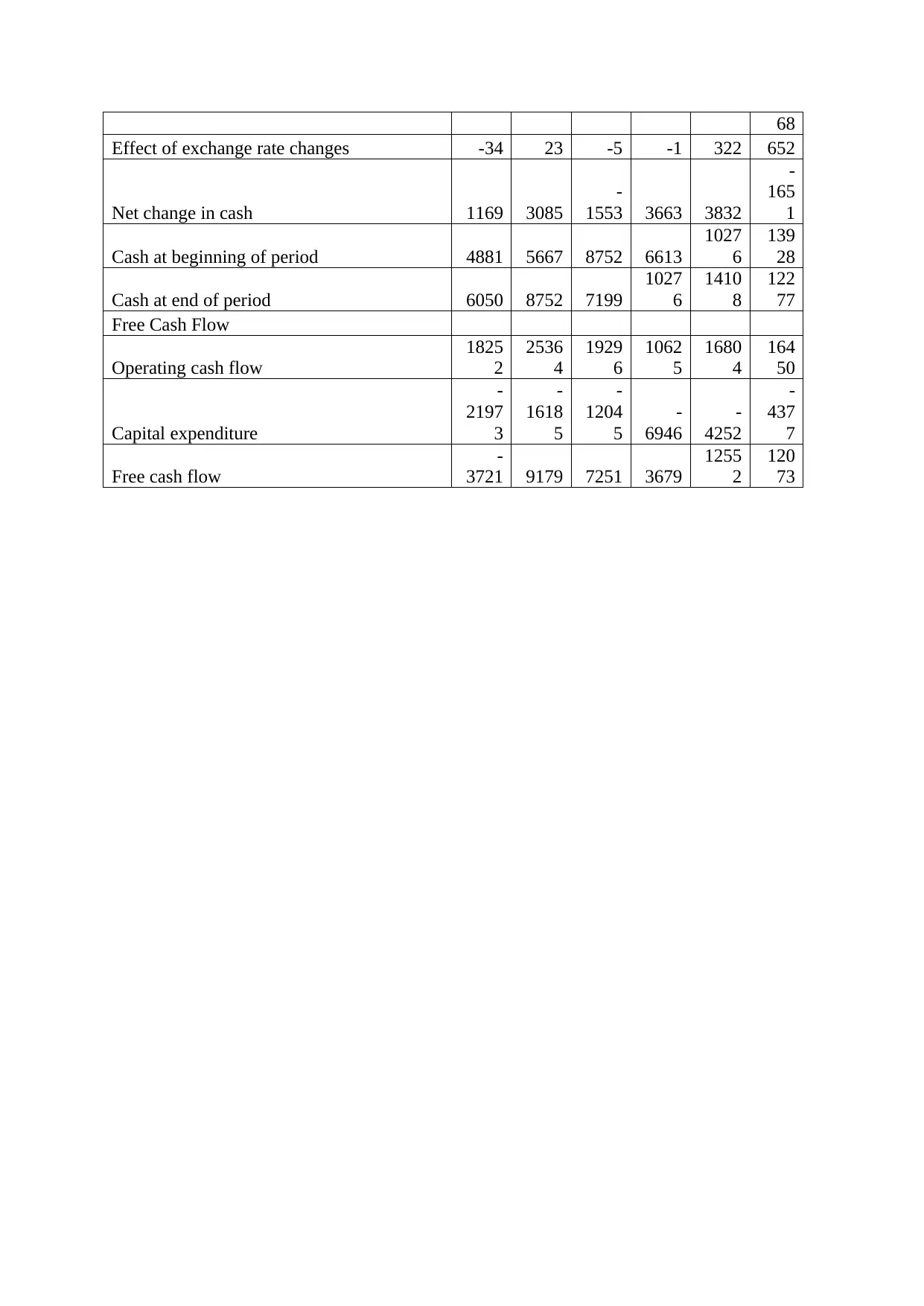
68
Effect of exchange rate changes -34 23 -5 -1 322 652
Net change in cash 1169 3085
-
1553 3663 3832
-
165
1
Cash at beginning of period 4881 5667 8752 6613
1027
6
139
28
Cash at end of period 6050 8752 7199
1027
6
1410
8
122
77
Free Cash Flow
Operating cash flow
1825
2
2536
4
1929
6
1062
5
1680
4
164
50
Capital expenditure
-
2197
3
-
1618
5
-
1204
5
-
6946
-
4252
-
437
7
Free cash flow
-
3721 9179 7251 3679
1255
2
120
73
Effect of exchange rate changes -34 23 -5 -1 322 652
Net change in cash 1169 3085
-
1553 3663 3832
-
165
1
Cash at beginning of period 4881 5667 8752 6613
1027
6
139
28
Cash at end of period 6050 8752 7199
1027
6
1410
8
122
77
Free Cash Flow
Operating cash flow
1825
2
2536
4
1929
6
1062
5
1680
4
164
50
Capital expenditure
-
2197
3
-
1618
5
-
1204
5
-
6946
-
4252
-
437
7
Free cash flow
-
3721 9179 7251 3679
1255
2
120
73

1 out of 18
Your All-in-One AI-Powered Toolkit for Academic Success.
+13062052269
info@desklib.com
Available 24*7 on WhatsApp / Email
![[object Object]](/_next/static/media/star-bottom.7253800d.svg)
Unlock your academic potential
© 2024 | Zucol Services PVT LTD | All rights reserved.




